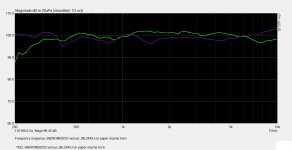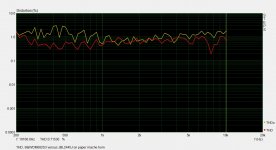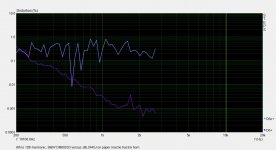'Dynamics' was hardly a leading virtue of IMP, no ?Thus there should be more important issues involved there.
- Elias
More succinctly: "dynamics" doesn't seem to have any relation at all the "auditory scene", which is more concerned with soundstage and imaging effects. (.."Auditory scene" in relation to the loudspeakers under the article seemed to be the point of the thread.)
Still, either thread "jacking" or simply thread tangent - it is an interesting discussion.
I'm kind of surprised you haven't opened-up an IMP thread yet.
I'm only questioning whether it's correct to call that "more dynamic" . . .
Questioning is a reasonable position. Concluding that anyone knows the answers is not. "Dynamics" is not something where the jury is in - we are all still deliberating.
That has not been my experience. Sometimes, but not every time. Certainly louder and cleaner is going to sound dynamic. But I've walked into demos where the level was set and it sounded either dynamic or not. While louder will sound more dynamic, I don't think it's always the case.. . . and what I have observed is that every time questions of "dynamics" arise the mode of demonstration is "turn it up".
A couple of years back someone mentioned "false dynamics" and I asked what that was. The answer was peaky response that pops up certain notes or sounds leading to dynamics that are not in the recording. That does exist, for sure. I hope that most of us here are skilled enough to recognize that.
Indeed . . . but then ORION also has "wandered off topic" and been superceeded by a (in several ways) better design. Still, as one of the best speakers of its time for "realistically" reproducing orchestral music in a "home" environment it, and some of the concepts it popularized, remain decidedly "interesting" topics of discussion. Certainly the questions raised about "reflected" sound, be they about level, delay or direction, and their contribution to (re)creating a plausible "acoustic scene", are anything but resolved.This thread long ago wondered off topic
"Dynamics" maybe not so much. I've brought recordings straight home from rehearal, and when played at hall level while memory was fresh noticed no reduction in "dynamics" compared to the original. Other flaws for sure (recordings never sound quite "real" in such comparisons), but "dynamics" . . . not an issue. At least not as I understand the term . . . and no one here has, so far, defined it in a way that I can associate with anything I hear, or can measure.
I have heard thermal compression in sound reinforcement systems that were "teasing the smoke" . . . but I think John K has fully discounted the possibility of that being an issue at home listening levels. I wouldn't so quickly discount it at a frat party (get horns, guys, not ORION or LX521), but for me anyway that was half a century ago, and is now definitely in the "does not apply" catagory. I'm one of those old coots that complains that the sound in the movie theater is "too loud" . . . (and sounds like scat to boot). Maybe they need better horns . . .
I am not so sure that I equate just getting loud with being dynamic. I have heard many loud speakers that are anything but dynamic. One of the comments that I remember people using to describe the sound of some speakers was slow. Everything is smeared in time, no resolution to the details. A dynamic speaker would make a piano sound like it was in the room, a difference between a cymbal and triangle in the upper reaches, a voice that makes you turn around as you think they are in the room, these are the things I equate with dynamics.
I've worked with eight or ten different Steinways and the two larger Faziolis, and can say with some confidence that nothing reproduces what they sound like on stage. There are a lot of reasons, from microphones to speakers, but it just ain't happening. If the recording was made with (relatively) remote mic placement, however, my ORION came as close as anything I've heard to what they sound like out in the hall.A dynamic speaker would make a piano sound like it was in the room
As close . . .
Well your goal is to make it sound like you have a piano in the room Mr. Phelps. This mission of the mission impossible force is to make it sound like you have a real piano in the room. When you can do that you have competed this secret mission. We will disregard you if you can not accomplish this mission, good luck.
Well your goal is to make it sound like you have a piano in the room Mr. Phelps. This mission of the mission impossible force is to make it sound like you have a real piano in the room. When you can do that you have competed this secret mission. We will disregard you if you can not accomplish this mission, good luck.
Mission Impossible Theme(full theme) - YouTube
I understand that, but I disagree. Most people rate the dynamics of a speaker in subjective terms - they just listen to it. There is a consistency across several decades and cultures that high efficiency speakers sound more dynamic than low efficiency. That's a common subjective assessment, so we might ask "why?"
Reviews of high efficiency speakers using pro drivers actually drove me to build something like Econowave (~97db). But subjectively the dipoles (~86db) sounded much more dynamic than them, especially the way they reproduce drum/snare attacks.
It might be that the freely suspended driver cones does not need to 'fight' anything. Or less.
I've been trying to dig into this problem of quantifying dynamics. Here's some tests I ran recently.
Test Equipment: STEPS (ARTA), EMU 0204 USB soundcard, Dayton mic. Calibration using sound calibrator (+-0.5db), i.e., SPL values are absolute. Amp is Class A solid state rated to 40W at 4 ohms, so the higher harmonics driving the B&W should be low (but I haven't checked).
I wanted to find out what made the tractrix horn plus JBL 2445 combination sound so "dynamic" compared to a standard speaker, such as the B&W DM602 that I have on hand. This B&W is a standard two-way, with the woven kevlar (yellow) driver and metal tweeter.
The test is to measure distortion at 100 db at 2m. It is an indoor test and is somewhat corrupted by reflections, but it still shows something (IMO). The mic is setup at 1m, and the result is normalized for 2m.
So, here's the data. The first pic shows the frequency response of the JBL2445 on the tractrix horn and the B&W. It is 3rd octave smoothed. I was shooting for 100 db at 1 kHz, and made no effort to EQ the rest of the response. The horn/JBL combo is the one that has more output at 2 kHz. The next pic shows the THD of the two and it's pretty close.
But we know that THD is meaningless and higher harmonics are important. So, the next pic shows the 6th-12th harmonics. Overlay is the B&W data. And now, some difference shows up. The horn is way lower than the B&W. The B&W distortion is also less smooth, but that may be because of the reflections.
STEPS uses a heterodyne method for calculating distortion. I played with the integration time and other parameters a bit and found that apart from the integration time, not much else has a big impact on the result. If someone wants to suggest optimal values, I'm all ears. I'm still not certain whether I'm using the right values.
Reflections are definitely corrupting the B&W data, but the important thing I feel is to look at the overall trend and not the absolute value at a single frequency.
Test Equipment: STEPS (ARTA), EMU 0204 USB soundcard, Dayton mic. Calibration using sound calibrator (+-0.5db), i.e., SPL values are absolute. Amp is Class A solid state rated to 40W at 4 ohms, so the higher harmonics driving the B&W should be low (but I haven't checked).
I wanted to find out what made the tractrix horn plus JBL 2445 combination sound so "dynamic" compared to a standard speaker, such as the B&W DM602 that I have on hand. This B&W is a standard two-way, with the woven kevlar (yellow) driver and metal tweeter.
The test is to measure distortion at 100 db at 2m. It is an indoor test and is somewhat corrupted by reflections, but it still shows something (IMO). The mic is setup at 1m, and the result is normalized for 2m.
So, here's the data. The first pic shows the frequency response of the JBL2445 on the tractrix horn and the B&W. It is 3rd octave smoothed. I was shooting for 100 db at 1 kHz, and made no effort to EQ the rest of the response. The horn/JBL combo is the one that has more output at 2 kHz. The next pic shows the THD of the two and it's pretty close.
But we know that THD is meaningless and higher harmonics are important. So, the next pic shows the 6th-12th harmonics. Overlay is the B&W data. And now, some difference shows up. The horn is way lower than the B&W. The B&W distortion is also less smooth, but that may be because of the reflections.
STEPS uses a heterodyne method for calculating distortion. I played with the integration time and other parameters a bit and found that apart from the integration time, not much else has a big impact on the result. If someone wants to suggest optimal values, I'm all ears. I'm still not certain whether I'm using the right values.
Reflections are definitely corrupting the B&W data, but the important thing I feel is to look at the overall trend and not the absolute value at a single frequency.
Attachments
Last edited:
I once was walking up to a friend's house and hear someone playing the piano, and I thought, gee, very nice playing; when I entered the house, I found out these were playing http://augene.myweb.hinet.net/images/products05.jpgI am not so sure that I equate just getting loud with being dynamic. I have heard many loud speakers that are anything but dynamic. One of the comments that I remember people using to describe the sound of some speakers was slow. Everything is smeared in time, no resolution to the details. A dynamic speaker would make a piano sound like it was in the room, a difference between a cymbal and triangle in the upper reaches, a voice that makes you turn around as you think they are in the room, these are the things I equate with dynamics.
Interestingly there are many different ways pianos are recorded. I had visited a site that actually demonstrated the sound of mics at different locations, but I do not have the link any more. However, you are correct that the piano is good for demonstrating dynamics simply because of the common harmonics yet the vast frequency generated by a combination of notes. When you have the drivers driven into the extremes of the driver's BL curve, the harmonics no longer sound like it's coming from the same piano. If we compensate for the non-liner BL curve, we get the dynamics back, but under certain amplifier tests, the distortion figures go up. Additionally, there are a whole bunch of other variables that need to be integrated throughout the system to get the most convincing and moving experience, and is not just an issue of the loudspeakers alone.
During listening, we need to try different volume levels as well; there is usually one volume setting that gives you the best experience, much like looking at a photograph, and this will vary depending on recording, much like how a photographer took a picture. For example, I have a violin/piano recording of a performance I had personally attended, an know where the mics were placed. If I turn the volume two loud, the ambiance in the original recording gets mixed with the room ambiance and possibly other issue such that it does not feel right, but if I get the volume to a certain level that resembles the original recording level, the feeling is right in the hall.
Now, if the recording was made in a more dead environment, we can expect that it should be like the performance is in our listening room because there are no reflection cues to produce contradictory environment sonic signatures.
Schoeps Microphone ShowroomI had visited a site that actually demonstrated the sound of mics at different locations, but I do not have the link any more.
Probably
Well your goal is to make it sound like you have a piano in the room Mr. Phelps. This mission of the mission impossible force is to make it sound like you have a real piano in the room. When you can do that you have competed this secret mission. We will disregard you if you can not accomplish this mission, good luck.
Maybe not.. Depending on the recording. Close mic would do that, but I think SL is more of the "best seat" believer. I hate when the mics are too close to the stage, unfortunately way too often. The image is already distorded then.. too loud, too upfront, not enough "hall signature"..
The Uppsala Magi serie is wonderfull, so is the Shostakovitch/Gebouw/Haitink one, and the Orions are definitely up the task dynamic wise!
I once had a regular 7" 2-way. In my opinion it struggled at higher volume levels, making the sound less dynamic and shrill. However, when I listened to these speakers outside in the open, this appeared not to be the case. I could push them really hard, to just below audible distortion without really noticeable compression or otherwise lack of dynamics.
My hypothesis has since been that dynamics are to a great extent related to the level of reflected sound. In a room with lively acoustics a low directivity speaker that is perfectly coping with the signal it is offered, may not sound very dynamic, while a small speaker with higher directivity that is pushed quite hard in a more damped room may sound more dynamic. It is not so much the short loud sound that gives the sense of dynamics, but the silence before the storm - the short quiet between for instance the hits of a snare drum. In the situation with more reverb and reflections the quiet part is just never as quiet as it could be.
As a side note: I've actually always been impressed with the dynamics of the Orion, but I'm sure the room and setup matter a lot.
My hypothesis has since been that dynamics are to a great extent related to the level of reflected sound. In a room with lively acoustics a low directivity speaker that is perfectly coping with the signal it is offered, may not sound very dynamic, while a small speaker with higher directivity that is pushed quite hard in a more damped room may sound more dynamic. It is not so much the short loud sound that gives the sense of dynamics, but the silence before the storm - the short quiet between for instance the hits of a snare drum. In the situation with more reverb and reflections the quiet part is just never as quiet as it could be.
As a side note: I've actually always been impressed with the dynamics of the Orion, but I'm sure the room and setup matter a lot.
Keyser, your comments are spot on!
I could not agree more as I myself have terrible acoustics, which I slowly try to cure with treatment. For high SPL, the room is definitely a key.
God bless we are not blaming the cables..
I agree with Keyser too, but to rule out the effect of cables is a bit....
My hypothesis has since been that dynamics are to a great extent related to the level of reflected sound.
That's my hypothesis too.
- Home
- Loudspeakers
- Multi-Way
- Linkwitz Orions beaten by Behringer.... what!!?


